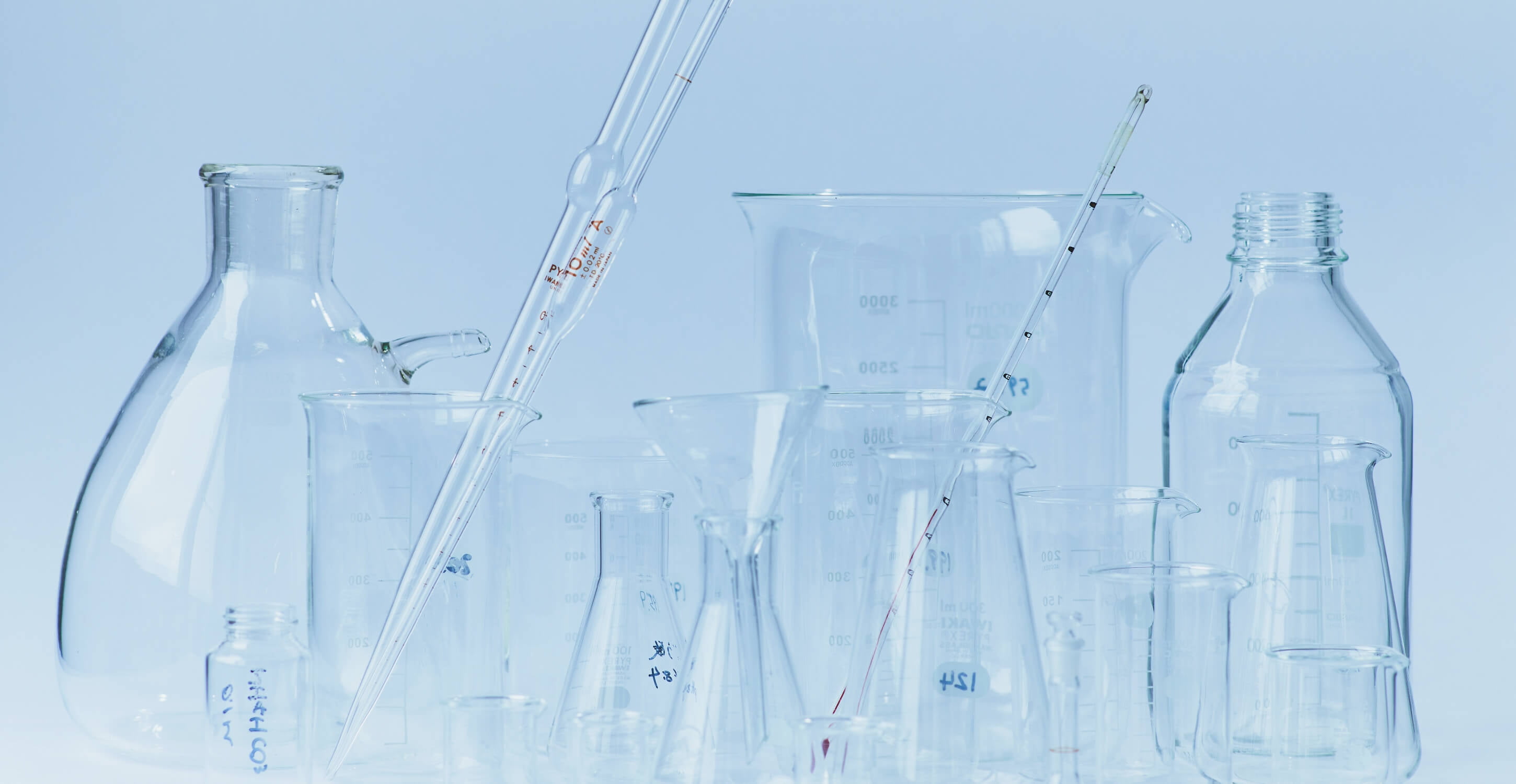
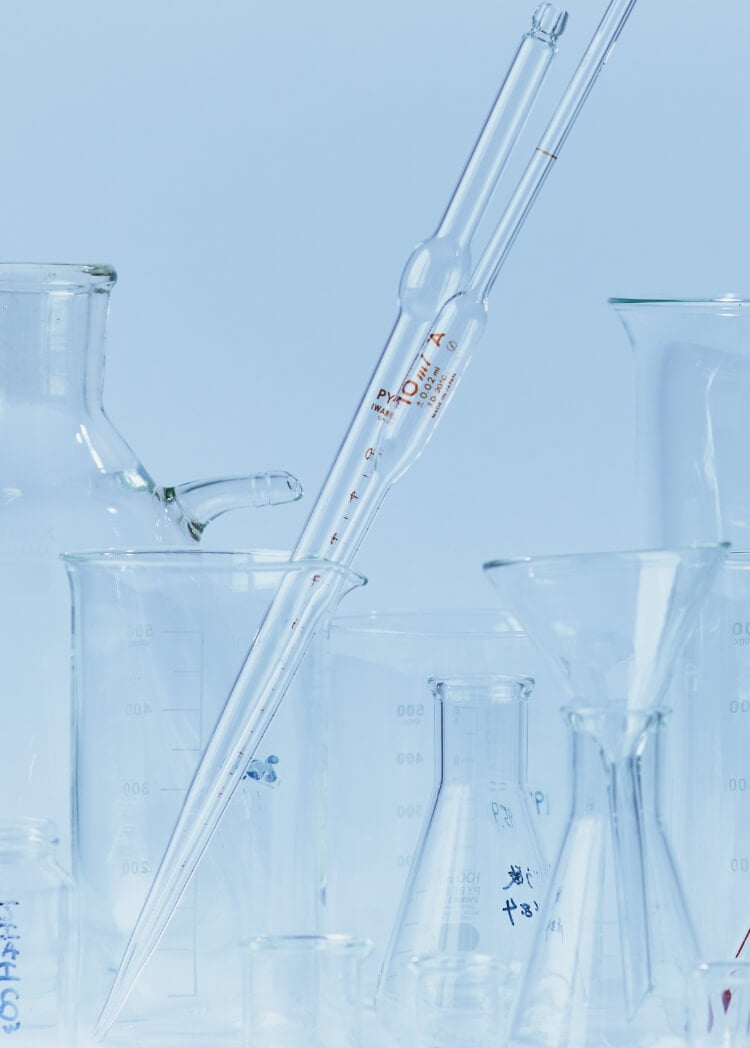



Micro-chemical process treatment reduces
polymers to low-molecular weight.
An information media that improves the resolution of nutritional science, including supplements,
whose chemical arguments have been vague,
and brings high absorption to the body and academia.
Absorption Science
- Report on joint research with the Industrial Research Institute of the Hokkaido Research Institute.
-
What is Micro Chemical Process?
To produce highly absorbable chondroitin sulfate oligosaccharides from high molecular weight chondroitin sulfate, we use a method called microchemical process. This is a method of conducting chemical reactions in a microspace in the order of microliters to milliliters. To put it simply, if you pass a raw material through a pipe, the target substance will be produced at the outlet.
In the production of chondroitin sulfate oligosaccharides, this is done continuously under high temperature and high pressure conditions. This method is clean and safe because it uses the energy of water to break down the bonds of sugar chains, and it can also kill spore bacteria, making it an excellent technology for food safety.
Many methods have been considered for the production of chondroitin sulfate oligosaccharides for industrial use, but unfortunately none of them have been successful.Therefore, the price of chondroitin sulfate oligosaccharide was an unbelievable 16 billion yen per kilogram.(Price of purified reagent grade:16000yen/mg)
At these prices, research and development, such as animal testing, cannot be done.However, we have succeeded in mass-producing chondroitin sulfate oligosaccharides for the first time in the world, which has allowed us to dramatically reduce this price. This has made it possible to conduct administration tests on animals and humans, and we believe that this has paved the way for the application of glycoparmaceuticals.S. Yamada et al., Mass preparation of oligosaccharides by the hydrolysis of chondroitin sulfate polysaccharides with a subcritical water microreaction system , Carbohydrate Research. 2013, 371, 16-21.
Kawahara et al, Mass production of purified chondroitin sulfate oligosaccharides with single molecular weight, Applied Glycoscience, 2021, 11(2), 94-99
- Why do our joints hurt as we get older?
-
Cartilage absorbs shock.
It is said that the knee joint is subjected to more than twice its weight in force when walking and more than five times its weight when running. The meniscus and articular cartilage absorb this shock.These two tissues act as cushions to prevent the femur and tibia, which are hard bones, from colliding with each other.

Cartilage wears out, but regeneration is weak.
The knee cartilage is constantly subjected to strong forces such as body weight, which causes constant wear and tear on the cartilage and meniscus. Cartilage is a very slow regenerating tissue in the body.It is thought that this is because cartilage tissue has very few blood vessels and nerves.This slow-regenerating cartilage tissue becomes thinner and thinner with age.The most common cause of age-related knee joint pain is wear and tear of the cartilage.
Osteoarthritis of the knee due to wear and tear of cartilage is a national disease.
If you take an X-ray of a healthy person's knee joint, you can see that there is a gap between the upper femur and the lower tibia.In this gap, there is cartilage that does not show up on X-rays. Osteoarthritis is when this cartilage becomes thin and the gap partially disappears. Because the cartilage has worn away, the gap is narrow and in some areas, the bones are in contact with each other. This situation causes pain and is diagnosed as osteoarthritis of the knee. Currently, the Ministry of Health, Labor and Welfare has announced that there are more than 7 million patients with knee osteoarthritis in Japan, mainly the elderly.
- What can supplements do for you?
-
Supplements are not medicines. However, no one believes that food has no medicinal value.Pharmaceuticals are only defined by humans, and just because something doesn't fit the definition doesn't mean it's useless to take it.It may just be that the research has not been done.For example, during the Age of Discovery, citrus fruits were needed to prevent scurvy, so it can be said that citrus fruits were a medicine at that time.
There are many ingredients in food, each of which plays a role in some way.Proteins, fats, and carbohydrates are just some of the most common ones. Supplements are food ingredients extracted and made into a form that is easy to consume, and for items that are difficult to consume on a daily basis, good use of these supplements can help maintain good health.However, the effects and benefits vary from person to person, and some may or may not be noticeable.
However, please check the quality of the product carefully to ensure that the useful ingredients are properly blended.Unfortunately, there are many shoddy products in the supplement industry, and there are so many mistakes in the information on the Internet that you need to be careful. - What is the absorption of supplements through oral intake?
-
Most food is not absorbed from the intestinal tract until it is digested and reduced to a molecular level.This is also an extremely important mechanism for the maintenance of life, because if something large enters the body, the body cannot produce what it needs for living tissue.To use an analogy, Lego can be made in various shapes because it is made up of small parts, but when the parts are large, the degree of freedom is greatly reduced and the things that can be made are limited.
Therefore, humans will only absorb small, digested pieces as nutrients. The same is true for supplements, where the size of the ingredient is very important for it to be absorbed. According to our latest research, chondroitin sulfate is absorbed into the intestinal tract only up to octasaccharide size (molecular weight of about 2,000) at most. All chondroitin sulfates commercially available outside of our company are high-molecular chondroitin sulfates, which are not absorbed by the intestinal tract.All chondroitin sulfates commercially available outside of our company are high-molecular chondroitin sulfates, which are not absorbed by the intestinal tract. - What is the difference between a nano type and a highly functional one?
-
Since chondroitin sulfate is a linear polymer like a chain, its cross section (equivalent to diameter) and length vary greatly.Even though the length is different, the cross section is the same, so the term "nano-type" refers to the length. The average molecular weight of nano-type chondroitin is about 2,000, so in this case the length is approximately 20 nanometers.
So why does the nano type provide better functionality? The answer also lies in the difference in absorbency. No matter how highly functional a material is, if it is not absorbed and delivered to the cells, it is of no use. The nano-type chondroitin is absorbed from the intestinal tract, enters the bloodstream, and is delivered to the cells so that it can function. - What can we say about the analysis of genes using cultured cells?
-
Why do we experiment with cells?
I want to know how living things work. I want to make a medicine that cures diseases. What kind of experiments should I do in such a case? There are two main ways to take the test: one without biology and one with biology.
Non-living tests involve chemical tests using substances such as proteins. Tests that use living organisms include tests on animals and clinical trials on humans.In between, there are tests using cells.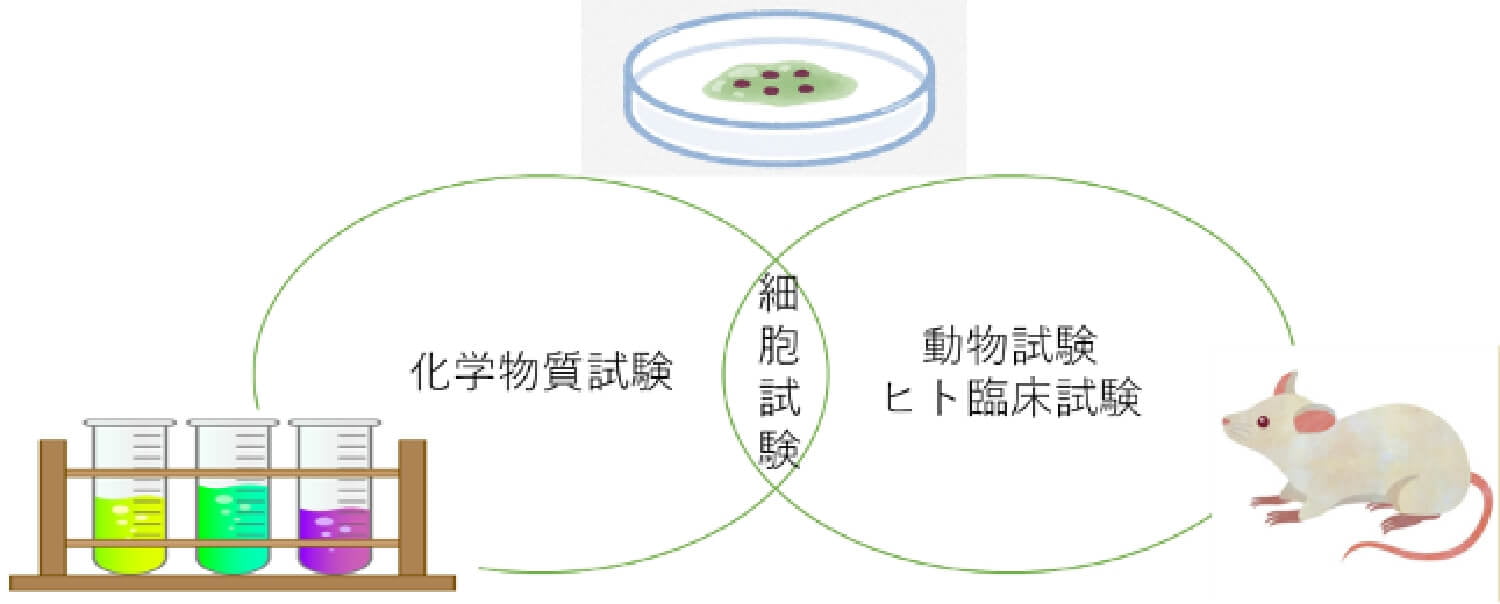
Chemical tests can tell us the mechanism of details that reveal the relationship between pure substances and substances. However, we do not know how they work on living organisms. In tests using living organisms, we can see the effect (effectiveness).
However, it is difficult to understand why it has such an effect, i.e., the mechanism of the test. This is because living things are made up of a variety of very complex mechanisms. In a sense, the cell test is the best of both worlds, as it shows a certain level of function in the organism and also shows a certain level of mechanism, as there are few mechanisms involved.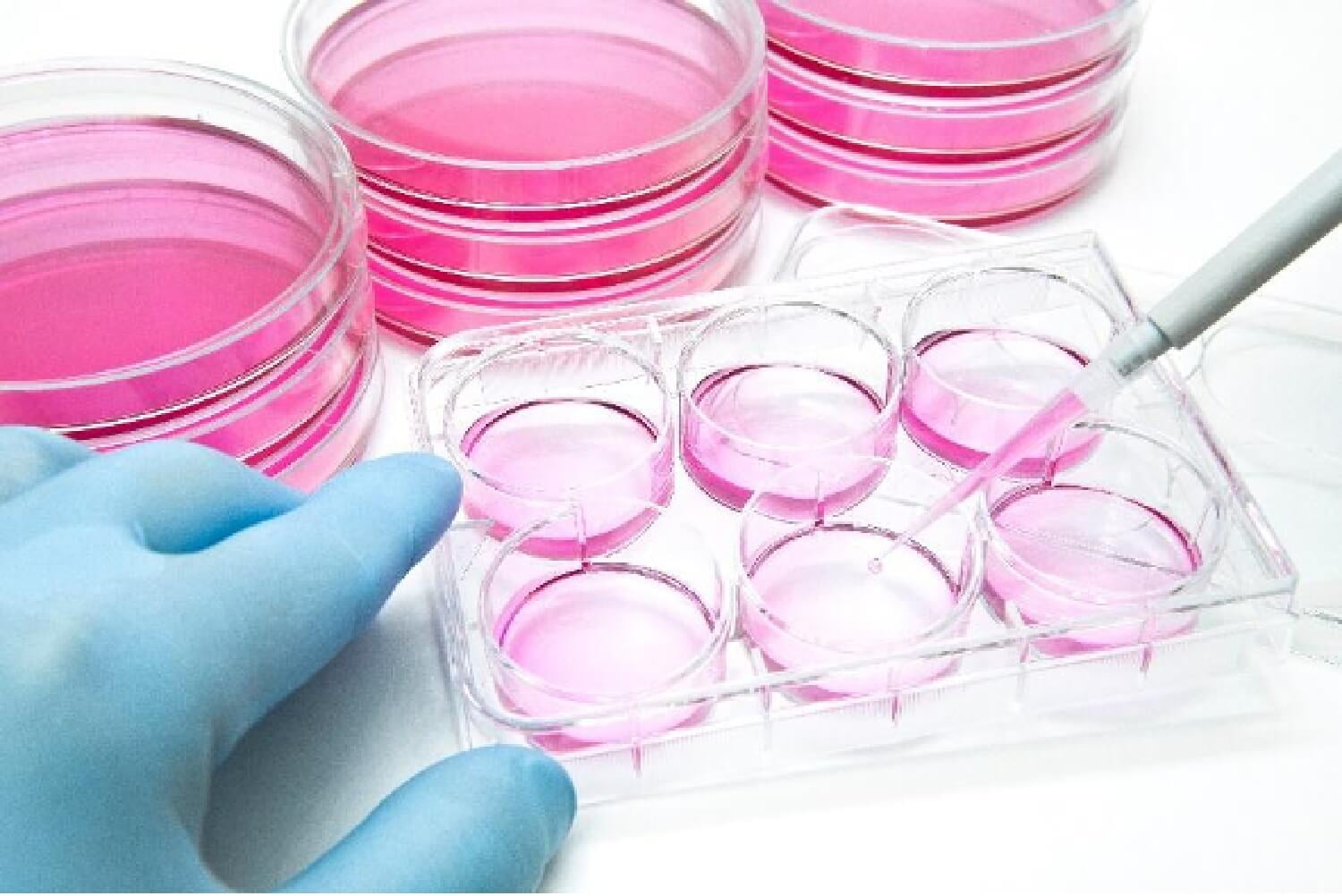
What's going on in the cell?
Living organisms are made up of cells as their smallest unit. The cell contains a large amount of genetic information made up of a substance called DNA. Genetic information is the blueprint for the proteins that a cell needs, and these are called genes. Humans have about 20,000 genes.
In order to produce a protein, a substance called RNA, which corresponds to the protein to be produced, is created from DNA on the gene (called transcription). This RNA makes proteins by arranging amino acids according to a blueprint (called translation).
One of these RNAs is needed for each protein you want to make. Therefore, if you want to make a lot of protein, you have to make a lot of RNA. Therefore, in order to find out what is going on in a cell, the amount of RNA produced can tell us a lot.This is called gene expression analysis.Examine gene expression in cells
Cells can also make new proteins in response to the addition of substances from outside the cell. Whenever this happens, the cell produces RNA, which is the basis for the protein. The number of newly produced RNAs is measured to see if the cells are responding to the substance, and RNAs can be measured in trace amounts by using PCR, just like the test for coronaviruses.
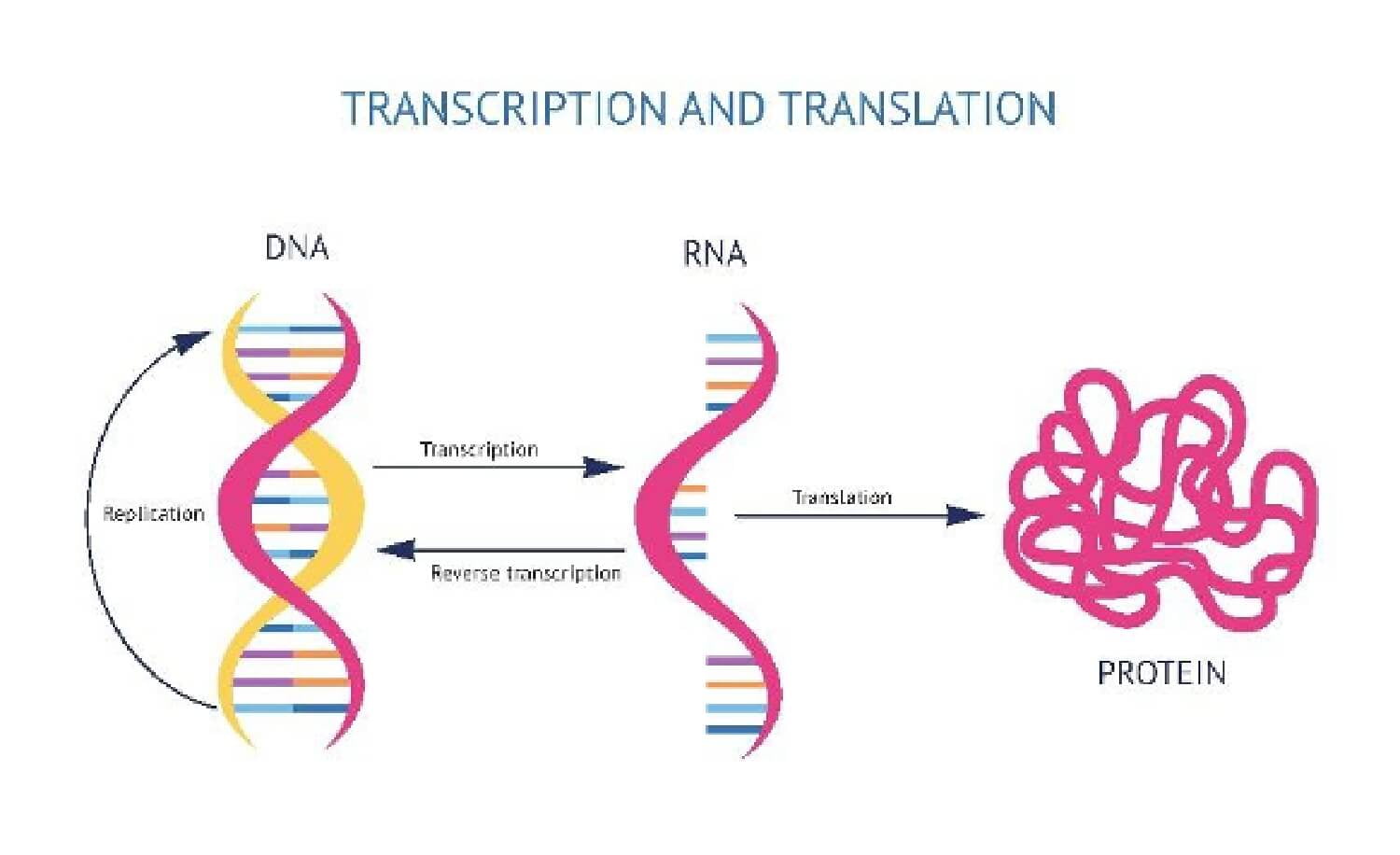
What cell tests can tell us
By adding a substance (called a test substance) to cultured cells and measuring the RNA, it is possible to determine how the cells respond to the substance. Experiments that would take months using animals or humans can now be done in a few days to two weeks, and we can clearly see what kind of protein we have come to produce.
- Research data on chondroitin sulfate oligosaccharides using cultured cells
-
Ⅰ.Effect of Chondroitin Sulfate Oligosaccharides on Chondrocytes in Mice
For the purpose of evaluating the functionality of chondroitin sulfate oligosaccharides, which have been reduced to low molecular weight by a microchemical process, in cells that form cartilage tissue, we cultured them in the mouse chondrogenic cell line ATDC5.(ATDC5 is a mouse tumor-derived undifferentiated cell that can reproduce chondrogenesis from an undifferentiated state in culture.)
High-molecular-weight chondroitin sulfate (HMWCS), low-molecular-weight chondroitin sulfate oligosaccharide (CSOS), and a low-molecular-weight disaccharide (CS2mer) isolated from CSOS were added (1 mg/mL) to ATDC5 and incubated. For gene expression analysis, genes encoding type II collagen, a cartilaginous extracellular matrix (ECM), and aggrecan core protein (Col2a1, Acan) were measured by real-time quantitative PCR (Fig. 1). In addition, the amount of CS in the ECM was quantified by HPLC after incubation (Fig. 2).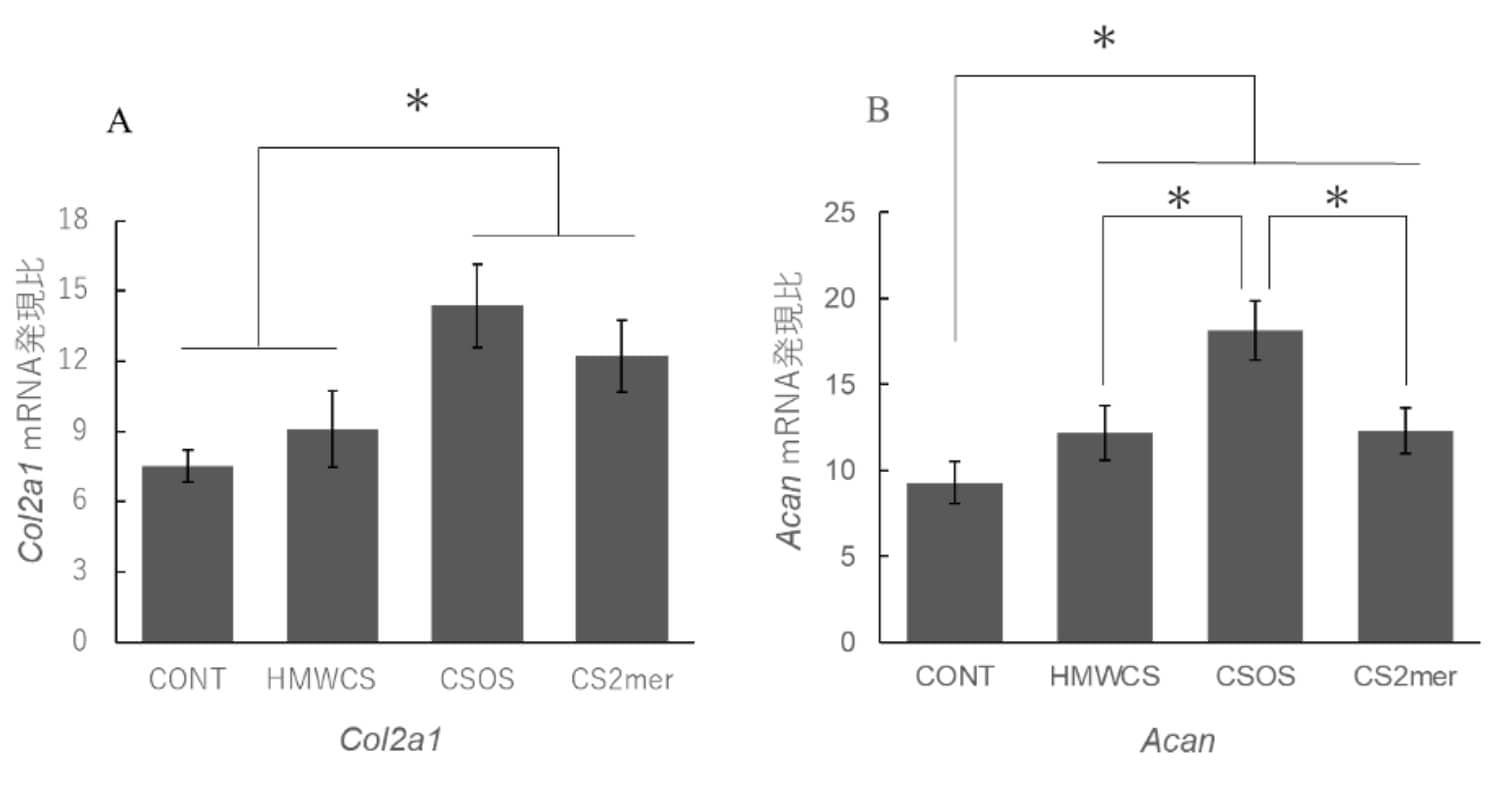
Fig. 1 Gene expression upon addition of various test substances on the 13th day of culture.
Each test substance(CONT:No additions,HMWCS:High molecular weight chondroitin sulfate average weight molecular weight 140,000,CSOS:Chondroitin sulfate oligosaccharides average weight molecular weight 2000,CS2mer: Chondroitin sulfate disaccharide average weight molecular weight 500)was added to the differentiation induction medium at a concentration of 1 mg/mL, and cells were collected on day 13 of culture for RNA extraction, followed by RT-qPCR using primers for each gene. The measured values were graphed as expression level ratios, with the expression value in undifferentiated cells on culture day 0 set to 1. Error bars are standard deviations. Multiple analyses were performed using the Tukey method. (* P < 0.05 )。A Expression of Col2a1 B Expression of Acan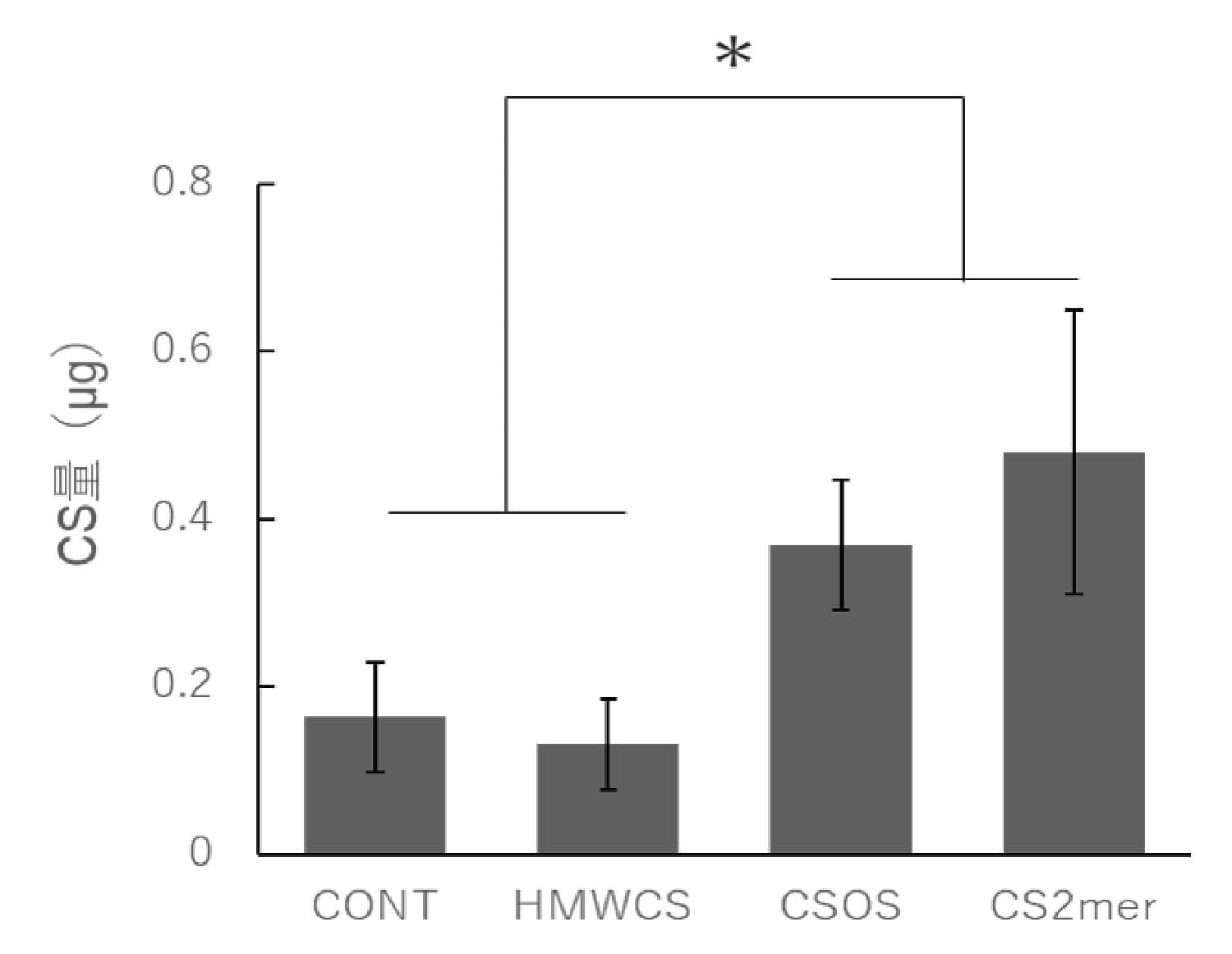
Fig. 2 Amount of CS contained in ECM at the time of incubation with various test substances on the 19th day of incubation.
Each test substance(CONT:No additions,HMWCS:High molecular weight chondroitin sulfate average weight molecular weight 140,000,CSOS:Chondroitin sulfate oligosaccharides average weight molecular weight 2000,CS2mer: Chondroitin sulfate disaccharide average weight molecular weight 500)was added to the differentiation induction medium at a concentration of 1 mg/mL, and on the 19th day of culture, the cell mass was collected by centrifugation and the amount of CS was measured. The amount of CS was determined from HPLC using a Superdex 30 Increase10/300 column. CS contained in the ECM was digested with CSaseABC and detected as CS disaccharide at UV240 nm.Quantification was performed by comparison with a calibration curve obtained from the CSaseABC degradation product of CS-A as a standard.Error bars are standard deviations. Multiple analyses were performed using the Tukey method.(* P < 0.05)As a result,Chondroitin sulfate oligosaccharide and chondroitin sulfate disaccharide significantly up-regulated the expression of type II collagen gene and significantly increased the amount of chondroitin sulfate as extracellular matrix, compared to high-molecular-weight chondroitin sulfate. These results indicate that chondroitin sulfate oligosaccharides may be more useful in the formation of cartilage tissue than high-molecular chondroitin sulfate.
- Absorption research data of chondroitin sulfate oligosaccharides
-
Ⅰ.Reversal enterography
The reverse side of the intestine removed from the rat was inverted, and one side was tied off, and then a polyethylene tube was tied to the other side. Make two of these. Inverted intestine tubes were promptly placed in 15-mL tubes containing 10 mL of each test solution that had been pre-warmed to 37°C. One tube was shaken for 30 min and the other tube was shaken gently for 60 min while 95% O2-5% CO2 gas mixture was blown into the tube. For the test solution, polymeric chondroitin sulfate (Mw.=150,000) and chondroitin sulfate oligosaccharide (Mw.=2,000) were dissolved to 20 mg/mL in each pH 7.4 saline solution.
The inner and outer fluids of the inverted intestinal tract were sampled at each time point, and the chondroitin sulfate concentration was measured using the carbazole method.
<Resalt>
Chondroitin sulfate oligosaccharides were found to have 254 times higher intestinal membrane permeability than high-molecular-weight chondroitin sulfate.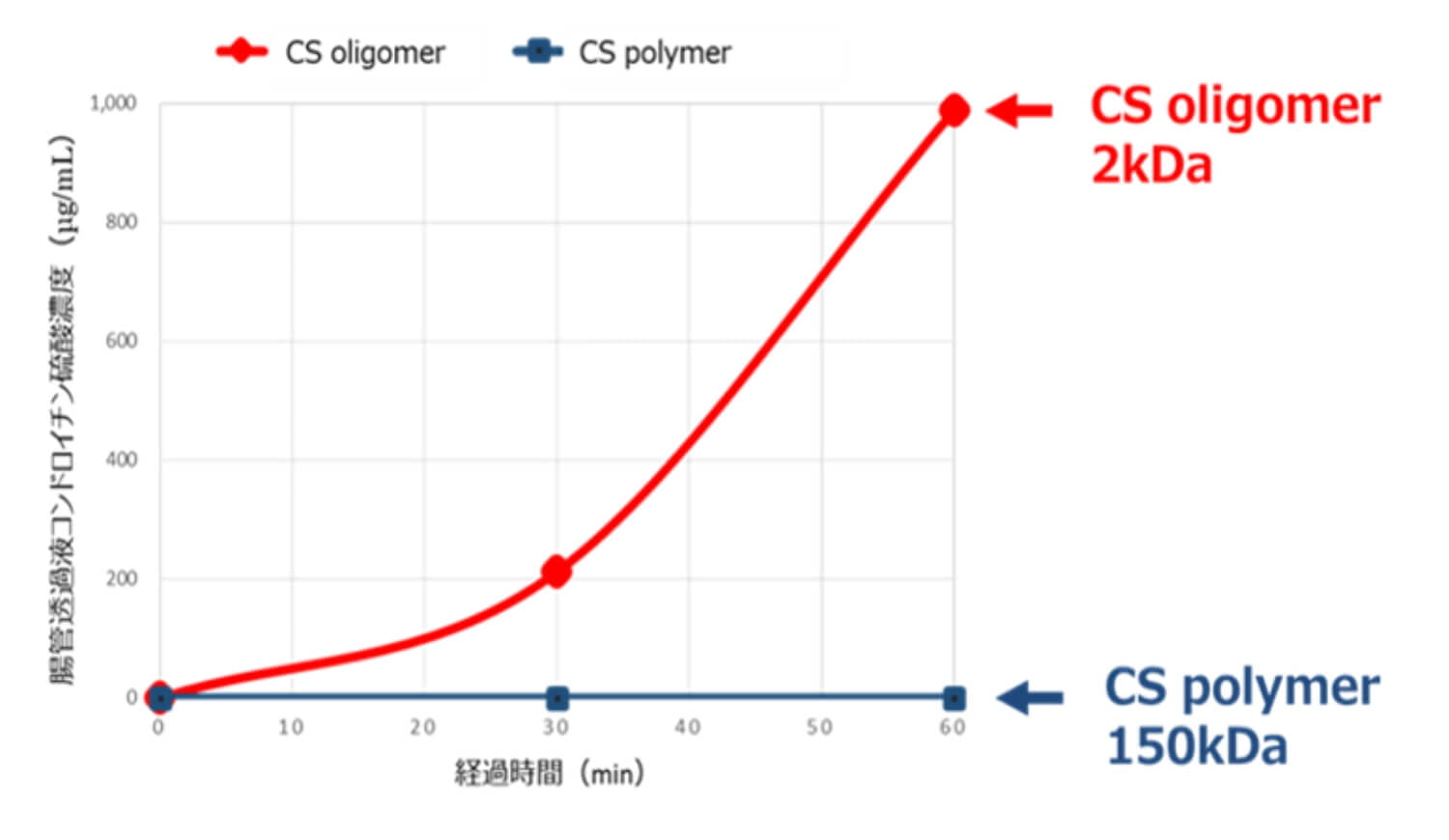
Ⅱ.Single oral administration study in rats Absorption (disposition) of chondroitin sulfate oligosaccharides
In an oral administration study to rats, no chondroitin sulfate was detected in the urine or feces of the group taking conventional chondroitin sulfate, which is a high polymer. This means that the orally ingested chondroitin sulfate was not absorbed in the small intestine, but was all broken down as food for intestinal bacteria in the cecum and colon.
On the other hand, chondroitin sulfate was detected in both urine and feces of the group fed orally with chondroitin sulfate oligosaccharides. This proves that the chondroitin sulfate oligosaccharides were absorbed in the small intestine, transferred to the bloodstream, and then eliminated through urine, and that those that were not fully absorbed were eliminated without much digestion by intestinal bacteria.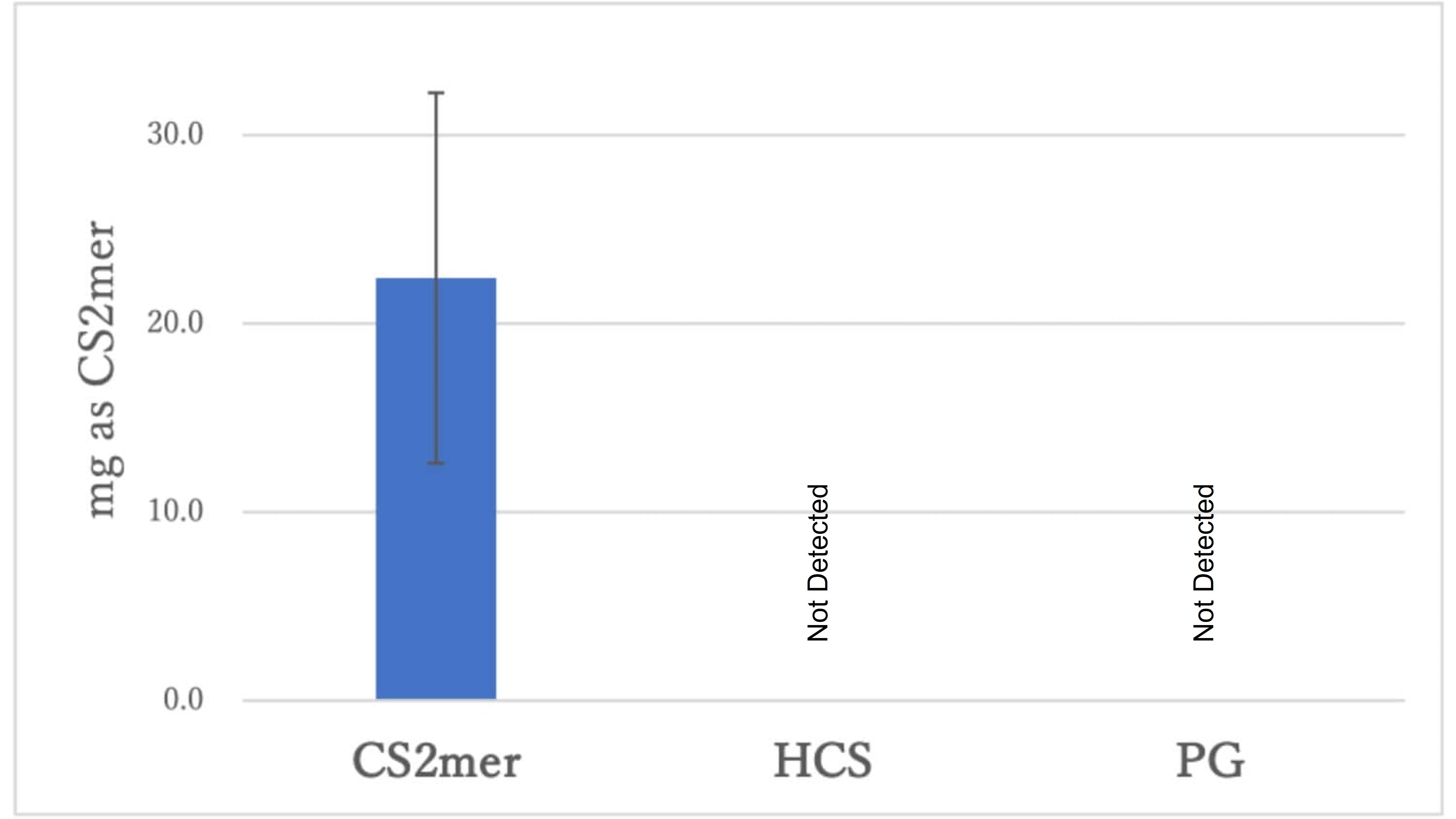
CS2mer : Chondroitin sulfate disaccharide (constituent of nano-type chondroitin)
HCS : High molecular weight chondroitin sulfate(Chondroitin sulfate liberated from core protein)
PG : proteoglycan (Chondroitin sulfate in a state bound to core protein)A single dose of 400 mg of the test substance was administered to rats, and all urine samples from 0 to 24 hours and 24 to 48 hours were collected to quantify the amount of the test substance contained.None were detected in the urine at 24-48 hours, so their description was omitted. The quantification was analyzed as chondroitin sulfate disaccharide, a common component.
Total urinary excretion per rat for 24 hours after administration of test substance(mg/head)
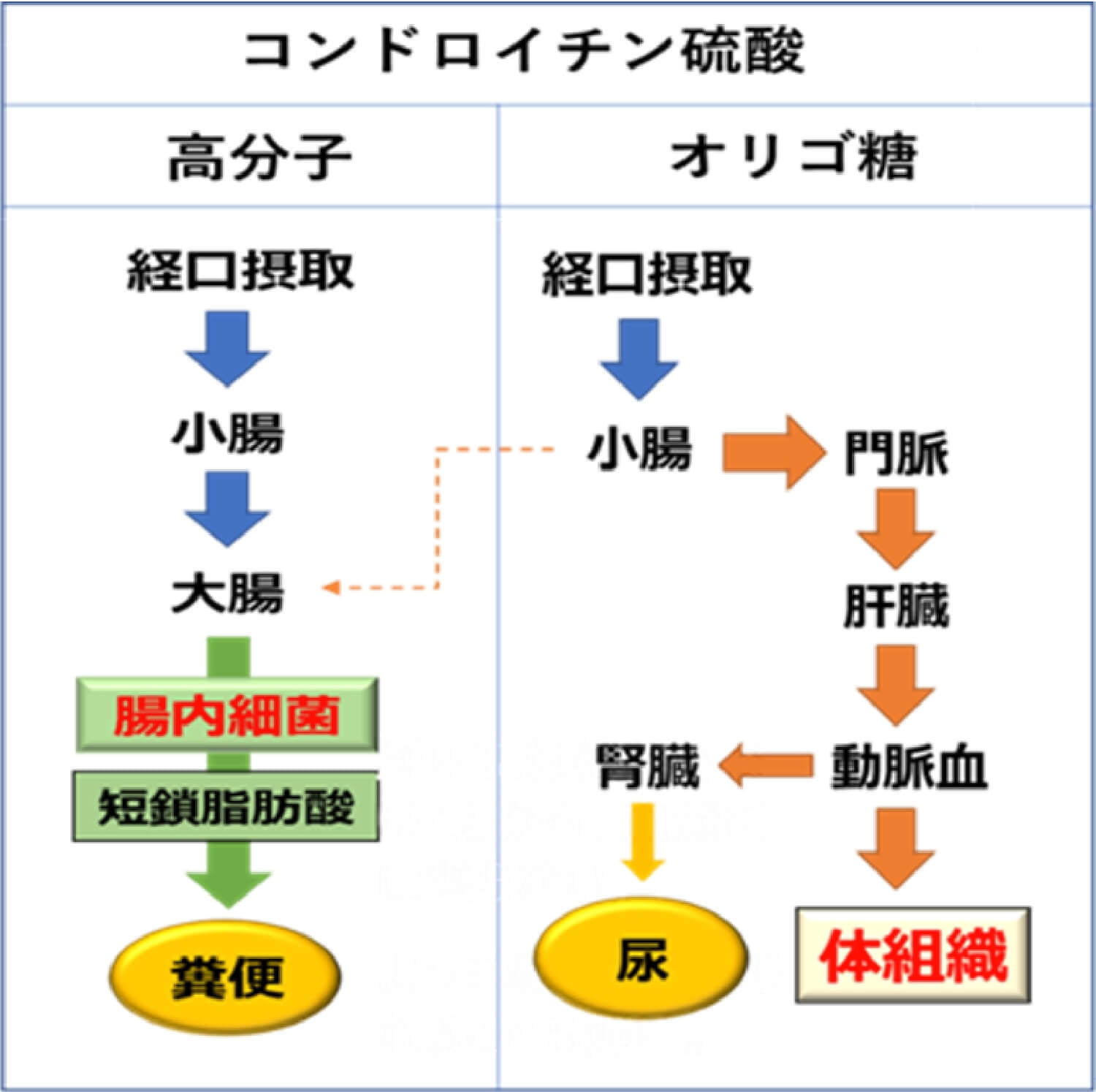
Ⅲ.Metabolism of chondroitin sulfate and chondroitin sulfate oligosaccharides by intestinal bacteria
Intestinal bacteria in animals secrete digestive enzymes that decompose chondroitin sulfate outside the body, break down polymer chondroitin sulfate into small pieces, take it into the body, and use it as a nutrient source. The action of this digestive enzyme is an enzyme that catalyzes the elimination reaction, so a double bond occurs on the cut surface of chondroitin sulfate. Intestinal bacteria (which form a double bond at the non-reducing terminal C4-C5) digest small molecule chondroitin sulfate very well in this state. On the other hand, chondroitin sulfate oligosaccharides produced by microchemical process treatment are decomposed by hydrolysis rather than elimination reaction, so that no double bond is formed on the cut surface. In our experiments using bacteria in rat feces, intestinal bacteria ate unsaturated sugars well, but only a small amount of saturated sugar. This result makes a lot of sense. This is because bacteria secrete enzymes outside the body because they themselves use enzymatic degradation products. Saturated sugar may be difficult to recognize as food because it is different from the components decomposed by the bacteria themselves.
<Result>
Polymeric chondroitin sulfate is degraded by intestinal bacteria, but is not absorbed from the intestinal tract because it is immediately used by intestinal bacteria. On the other hand, chondroitin sulfate oligosaccharides produced by microchemical process treatment are not used because they are difficult to recognize by intestinal bacteria, and migrate from the intestinal tract to the blood.
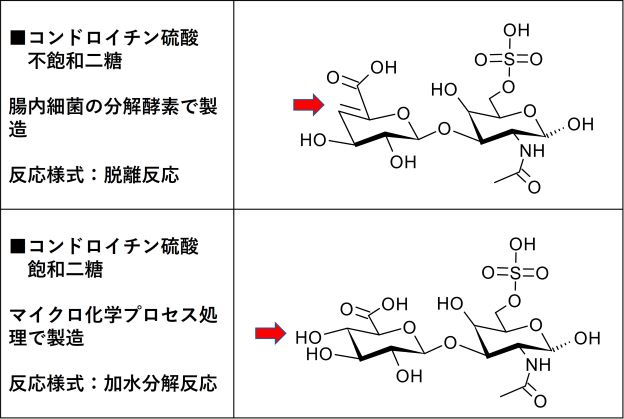
- Comparison of macromolecules and small molecules with respect to their absorption by the human body
In a human intervention study, it was confirmed that chondroitin sulfate oligosaccharide (nano-type chondroitin) was transferred into the bloodstream through oral intake. After oral intake, the blood concentration peaks in 2 to 3 hours, followed by the urine concentration in 4 to 5 hours.It has been proven that chondroitin sulfate oligosaccharides can be transferred into the bloodstream through oral intake and delivered to all tissues of the body through the bloodstream.
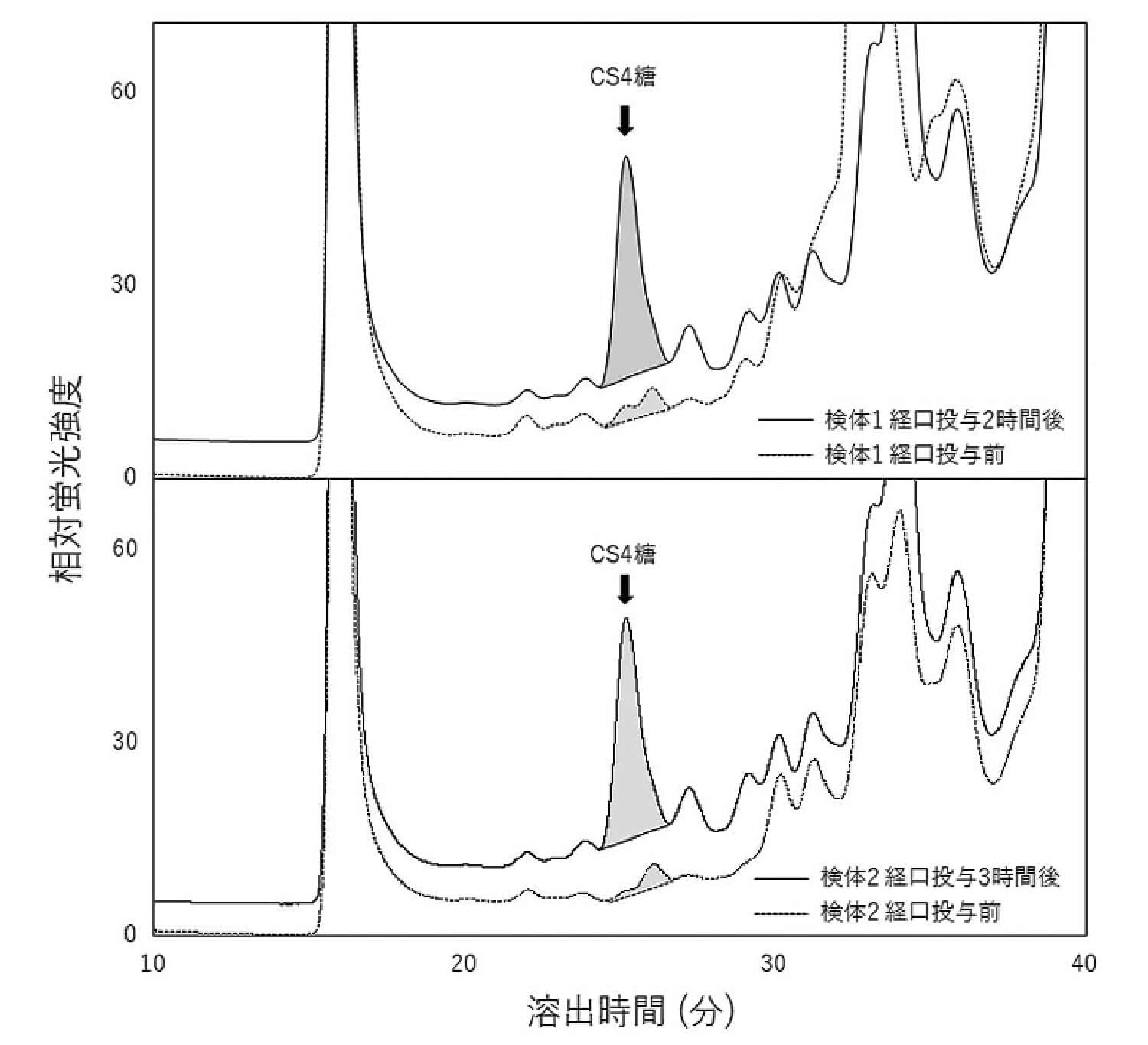
HPLC chromatograms of plasma from subjects who received CS4 sugar orally
The upper figure shows the chromatogram of the plasma sample of subject 1 (Sample 1), and the lower figure shows the chromatogram of the plasma sample of subject 2 (Sample 2). The dotted line is the chromatogram of the plasma sample before the administration of CS4sugar, and the solid line is the chromatogram of the plasma sample after the oral administration of CS4sugar.
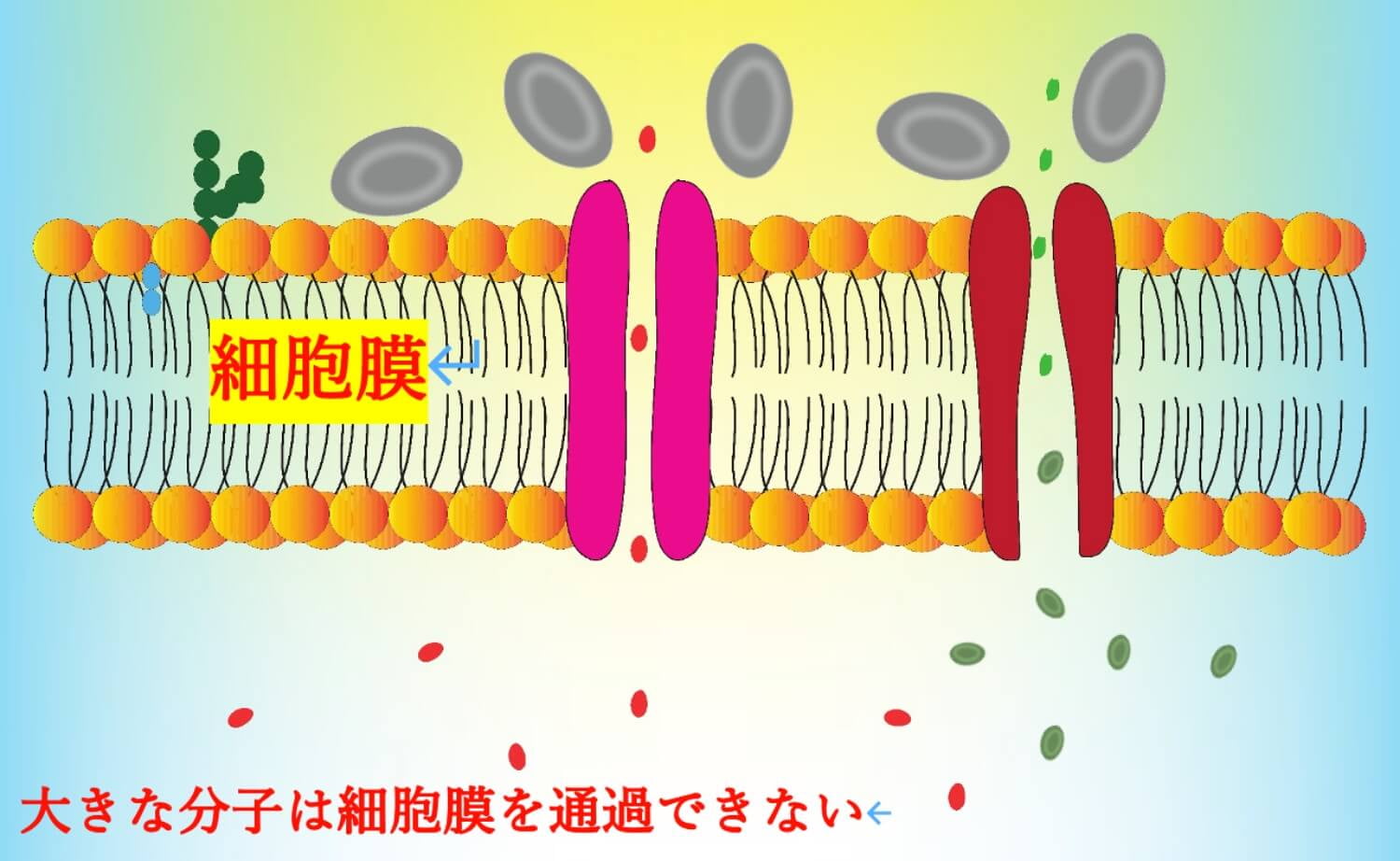
- Functional research data of chondroitin sulfate oligosaccharides
Ⅰ.Anti-inflammatory test
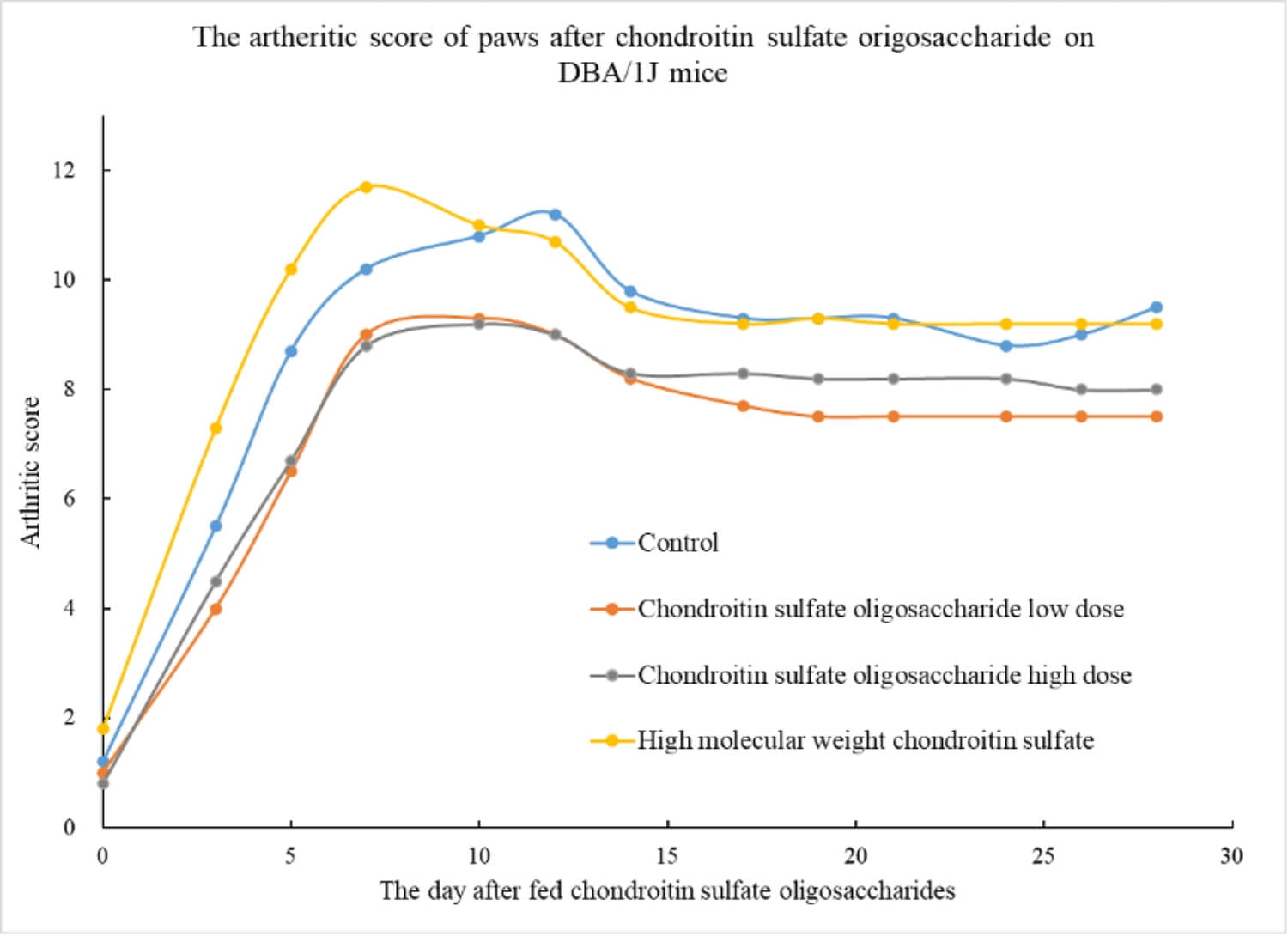
Anti-inflammatory effects of chondroitin sulfate with different molecular weights in arthritis-induced model mice
In this study, chondroitin sulfate oligosaccharide was administered at 100 mg/day and 400 mg/day as the test substance, and high-molecular-weight chondroitin sulfate at 400 mg/day for 28 consecutive days to four groups of arthritis-induced model mice, and the state of joint edema was evaluated by calculating a score.
<Results>
Chondroitin sulfate oligosaccharide was suggested to have the potential to improve arthritis at lower doses than high-molecular chondroitin sulfate.Ⅱ.Human intervention study (knee joint improvement)

Daily Oral Chondroitin Sulfate Oligosaccharides for Knee Joint Pain in Healthy Subjects A Randomized, Blinded, Placebo-Controlled Study.
The increasing rate of population aging in Japan has led to an increase in the incidence of osteoarthritis (OA).Chondroitin sulfate has been reported to reduce pain and swelling associated with OA and to improve knee function. We evaluated the safety and efficacy of oral chondroitin sulfate oligosaccharides on knee function in a randomized, double-blind, placebo-controlled, parallel-group study of healthy Japanese patients with knee arthralgia.
Subjects were randomly divided into a test group and a placebo group, and received active test capsules or placebo capsules containing 100 mg of chondroitin sulfate oligosaccharides daily for 8 weeks. The Japanese Knee Osteoarthritis Measure (JKOM), Visual Analog Scale (VAS), blood and physical examinations, and interviews were performed at weeks 0, 4, and 8.
JKOM scores were not significantly different between test groups, but in the group of subjects with poor VAS scores, the JKOM scores of subjects in the chondroitin sulfate oligosaccharide group were significantly lower than those in the placebo group at 8 weeks.
Subjects were randomly divided into a test group and a placebo group and received active test capsules or placebo capsules containing 100 mg of chondroitin sulfate oligosaccharides daily for 8 weeks. The Japanese Knee Osteoarthritis Measure (JKOM), Visual Analog Scale (VAS), blood and physical examinations, and interviews were performed at weeks 0, 4, and 8.
JKOM scores were not significantly different between the test groups, but in the group of subjects with poor VAS scores, the JKOM scores of the subjects in the chondroitin sulfate oligosaccharide group were significantly lower than those in the placebo group at 8 weeks. Furthermore, the chondroitin sulfate oligosaccharide-treated group tended to improve the subjects' scores on the stand-up test to assess the risk of locomotive syndrome. No abnormalities or serious adverse events were observed in physical examinations, blood tests, or medical interviews during the treatment period.M. Nishimura, N. Miyamoto and J. Nishihira, Daily Oral Chondroitin Sulfate Oligosaccharides for Knee Joint Pain in Healthy Subjects: A Randomized, Blinded, Placebo-Controlled Study, The Open Nutrition Journal, 2018, 12, 10-20.
Ⅲ.Antiplatelet effect
Oral intake of 100 mg/day of chondroitin sulfate oligosaccharide for 4 weeks by healthy subjects resulted in a significant decrease in platelet aggregation capacity.
Permits are in progress2021- 94977 Antiplatelet agents, platelet adhesion inhibitors, platelet aggregation inhibitors, antithrombotic agents, food compositions for inhibiting platelet adhesion and/or platelet aggregation, and food compositions for preventing or improving thrombosis.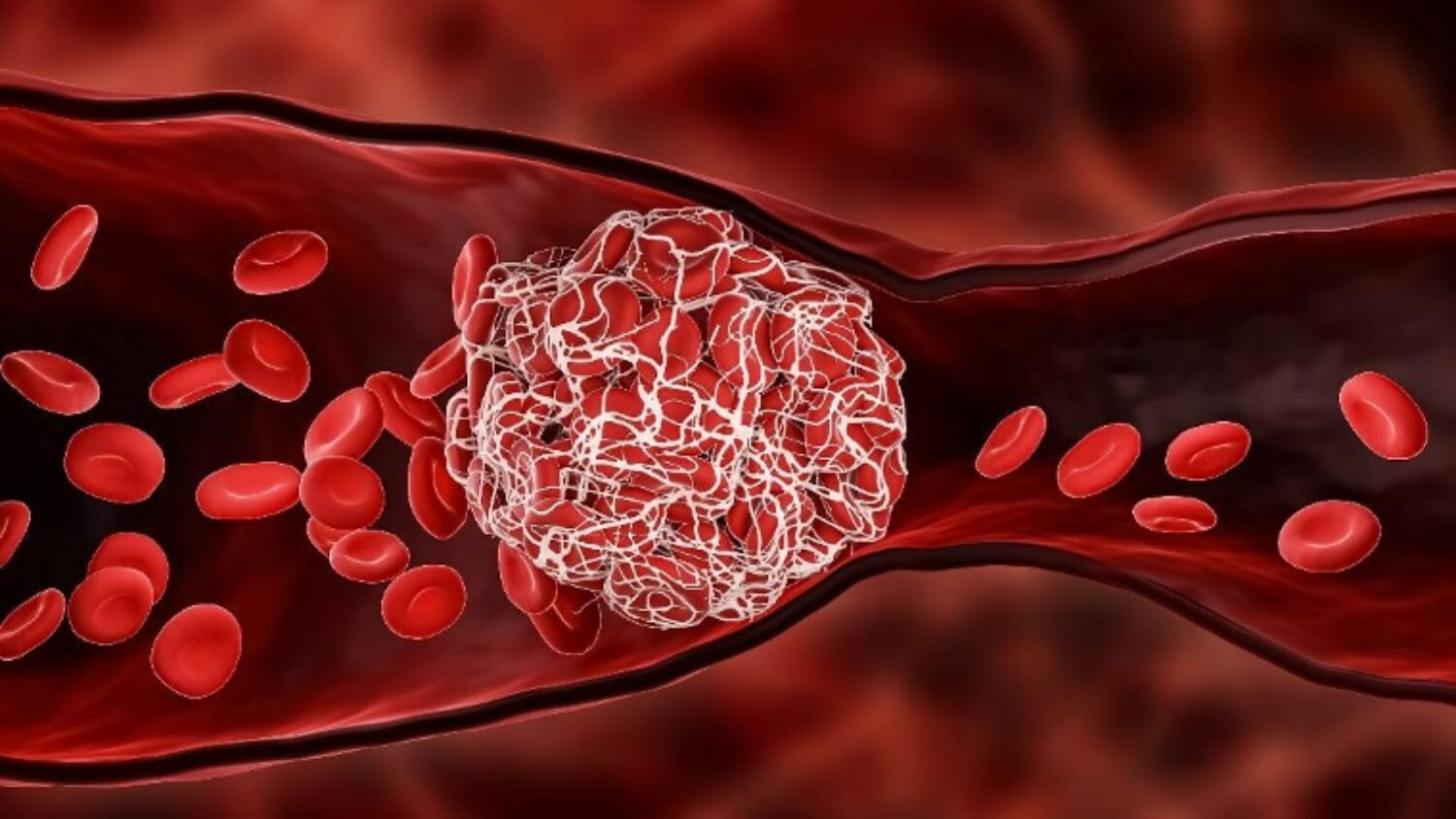
Ⅳ.Skin permeability of chondroitin sulfate oligosaccharides
Skin permeability tests of polymeric chondroitin sulfate and chondroitin sulfate oligosaccharides were performed using a cultured skin model. As a result, it was confirmed that the polymer chondroitin sulfate almost did not penetrate the skin, but the skin permeability of chondroitin sulfate oligosaccharides increased markedly in molecular weight dependence.
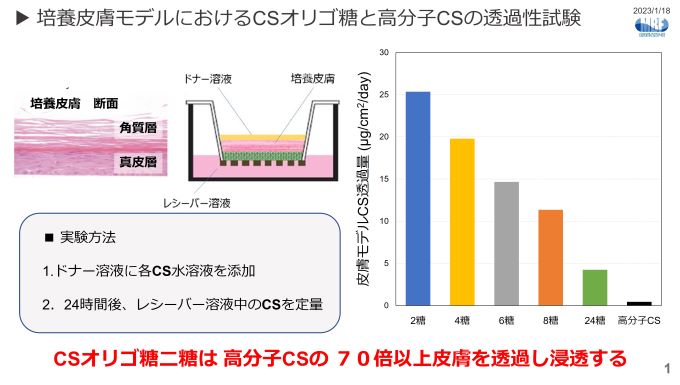
- Report on joint research with Hokkaido University
Ⅲ.Anti-fattening effect
A paper on the anti-obesity effect of chondroitin sulfate oligosaccharides derived from ray cartilage and chondroitin sulfate (polymer) derived from ray cartilage was published by Graduate School of Fisheries Science, Hokkaido University.
This study clearly shows the anti-obesity effect of chondroitin sulfate derived from the cartilage of Ganoderma lucidum. In vitro and in vivo studies have shown that chondroitin sulfate oligosaccharides derived from cassava cartilage have lipase inhibitory activity to inhibit the absorption of triglycerides in the intestine and adipocyte inhibitory activity to reduce lipid accumulation. This proved to control weight gain in high-fat-fed mice.
It has also been shown to prevent the transfer of endotoxin (bacterial toxin) into the bloodstream due to relaxation of intestinal tight junctions, which is caused by a high-fat diet.
【Overview】
Differences in the molecular weight of chondroitin sulfate result in different mechanisms of action for the anti-obesity effect of chondroitin sulfate from skate.High molecular weight chondroitin sulfate (CS polysaccharide that cannot be absorbed in the intestine) inhibits dietary fat absorption in the intestine by strong lipase inhibitory activity.
On the other hand, chondroitin sulfate oligosaccharides are easily absorbed in the intestinal tract, inhibiting fat cells and reducing lipid accumulation.
These results seem to be effective for functional foods aimed at anti-obesity, both by formulations containing chondroitin sulfate.Wen Li et al., Anti-obesity effects of chondroitin sulfate oligosaccharides from the skate Raja pulchra, Carbohydrate Polymers, 2019, 214, 303-310.
Ⅳ.Antioxidant activity
The properties of skate cartilage, which is rich in chondroitin sulfate (CS) and type II collagen, were investigated. Enzymatically hydrolyzed type II collagen peptide (CP) was prepared and its antioxidant activity was studied. High free radical scavenging activity was observed in the <3kDa fraction of papain hydrolyzed CP (Pa-CP), producing a thermally hydrolyzed chondroitin sulfate oligosaccharide (CSo) and analyzed for antioxidant activity.This activity is mainly due to the intermediate and end products of the non-enzymatic browning reaction formed by high temperature hydrolysis. In addition, the products may have contained flavonoid-like compounds. In addition, Pa-CP and CSo did not exhibit cytotoxicity.
Pa-CP and CSo have the potential to serve as valuable antioxidant functional foods due to their high intestinal absorption.Wen Li et al., Antioxidant and fibroblast-activating activities of the by-product of skate chondroitin extractive production, Sustainable Chemistry and Pharmacy ,2021, In Press
- Our Presentation of academic papers on research and development results
Bioactivity of ray cartilage chondroitin sulfate
Hashiguchi, T. et al. Demonstration of the hepatocyte growth factor signaling pathway in the in vitro neuritogenic activity of chondroitin sulfate from ray fish cartilage. Biochim. Biophys. Acta - Gen. Subj. 1810, 406–413 (2011).
Production of Chondroitin Sulfate Oligosaccharides by Micro Chemical Process
S. Yamada et al., Mass preparation of oligosaccharides by the hydrolysis of chondroitin sulfate polysaccharides with a subcritical water microreaction system , Carbohydrate Research. 2013, 371, 16-21.
Treatment of locomotive syndrome with chondroitin sulfate oligosaccharides
M. Nishimura, N. Miyamoto and J. Nishihira, Daily Oral Chondroitin Sulfate Oligosaccharides for Knee Joint Pain in Healthy Subjects: A Randomized, Blinded, Placebo-Controlled Study, The Open Nutrition Journal, 2018, 12, 10-20.
Anti-obesity effect of chondroitin sulfate oligosaccharides
Wen Li et al., Anti-obesity effects of chondroitin sulfate oligosaccharides from the skate Raja pulchra, Carbohydrate Polymers, 2019, 214, 303-310.
Purification method of pure chondroitin sulfate oligosaccharides
Kawahara et al, Mass production of purified chondroitin sulfate oligosaccharides with single molecular weight, Applied Glycoscience, 2021, 11(2), 94-99
Antioxidant activity of chondroitin sulfate oligosaccharides
Wen Li et al., Antioxidant and fibroblast-activating activities of the by-product of skate chondroitin extractive production, Sustainable Chemistry and Pharmacy ,2021, 23, 100499.
Chondroitin sulfate oligosaccharides in the blood and urine when chondroitin sulfate oligosaccharides were orally administered to humans were quantified
H. Mizuta et al,Quantification of orally administered chondroitin sulfate oligosaccharides in human plasma and urine, Glycobiology, Volume 33, Issue 9, September 2023, Pages 755–763, https://doi.org/10.1093/glycob/cwad054
- Latest Research Paper on Chondroitin Sulfate Oligosaccharides By External Resarcher
Wen Li et al., Antioxidant and fibroblast-activating activities of the by-product of skate chondroitin extractive production, Sustainable Chemistry and Pharmacy ,2021, 23, 100499.
Chondroitin sulfate oligosaccharides inhibit amyloid-β injury in neurons and have anti-Alzheimer's disease effects.
Na Zhao et al., Study on the relationships between molecular weights of chondroitin sulfate oligosaccharides and Aβ-induced oxidative stress and the related mechanisms, Glycobiology, 2021, Vol.31, no.4, 492-507.
Chondroitin sulfate oligosaccharides inhibit neuronal cell injury caused by amyloid β and have anti-Alzheimer's disease effect
Na Zhao et al., Study on the relationships between molecular weights of chondroitin sulfate oligosaccharides and Aβ-induced oxidative stress and the related mechanisms, Glycobiology, 2021, Vol.31, no.4, 492-507.
C- and D-type chondroitin sulfate oligosaccharides, extracted from shark and skate(ray) cartilage, prevent the development of knee osteoarthritis due to anticomplement activity.
Lian Li et al., Preparation of Low Molecular Weight Chondroitin Sulfates, Screening of a High Anti-Complement Capacity of Low Molecular Weight Chondroitin Sulfate and Its Biological Activity Studies in Attenuating Osteoarthritis, Int. J. Mol. Sci. 2016, 17, 1685; doi:10.3390/ijms17101685.
Low molecular weight chondroitin sulfate C suppresses colorectal cancer.
Ruiyun Wu et al., Structural analysis and anti-cancer activity of low-molecular-weight chondroitin sulfate from hybrid sturgeon cartilage, Carbohydrate Polymers. 2022, 275, 118700
Absorption terms
- Intestinal absorption
- Something that enters the body through the mouth and is taken into the body by the intestinal tract (mainly the small intestine).
- Oral intake
- To put a substance into the body by mouth. In animal experiments, either oral ingestion or intravenous injection is used, but for substances that are not absorbed intestinally, intravenous injection is the only way to go.
- Digestive enzyme
- Proteins that function to reduce the size of compounds on a molecular level. A typical example is salivary amylase, which breaks down starch into maltose.
- Enzyme
- A catalyst made of protein. It can be said that life is maintained by the action of enzymes. Since they are proteins, they are ineffective when taken by mouth because they lose their activity.
- Amino acid
- A general term for compounds that have an amino group and a carboxy group in one molecule. It is the smallest molecule that makes proteins.
- Saccharides
- As said, carbohydrates are the generic name for compounds consisting of carbon and hydroxyl groups. Glucose and galactose are typical examples.
- Lipid
- A compound consisting of an alkyl group and a carboxy group. A general term for similar substances such as oleic acid and linoleic acid. Unsaturated fatty acids are those that have double bonds in the molecule, and saturated fatty acids are those that do not.
- Nucleic acid
- A compound consisting of four nucleotides (a sugar, a base, and a phosphate compound).






